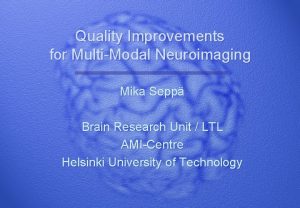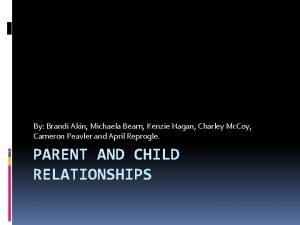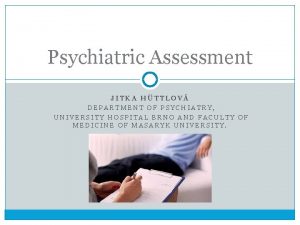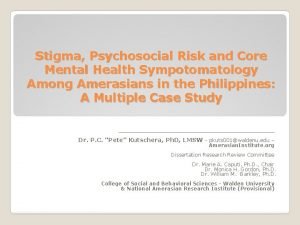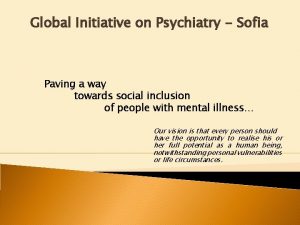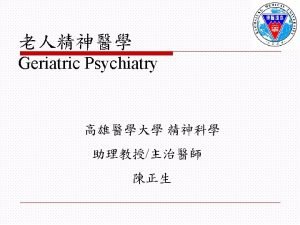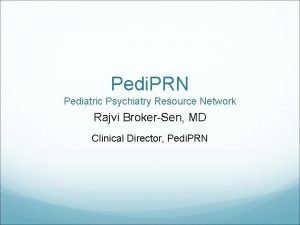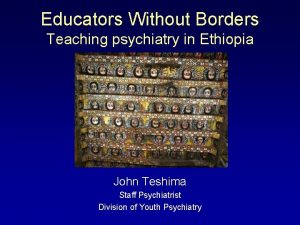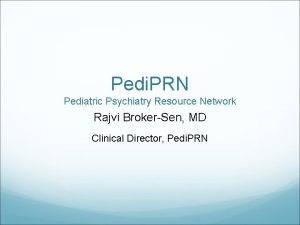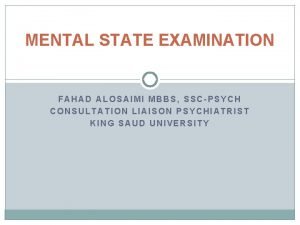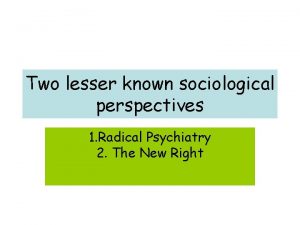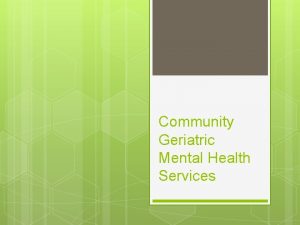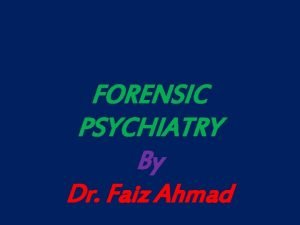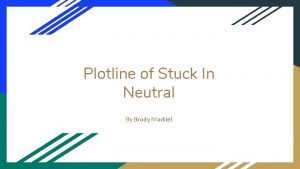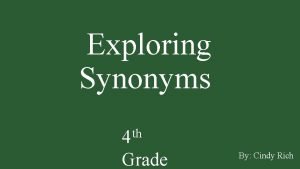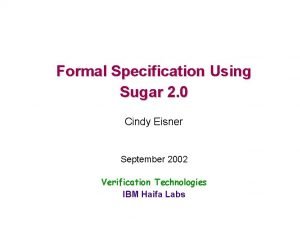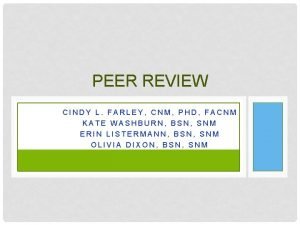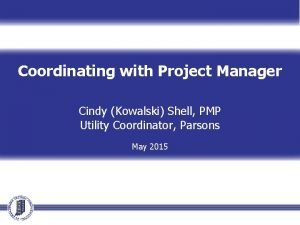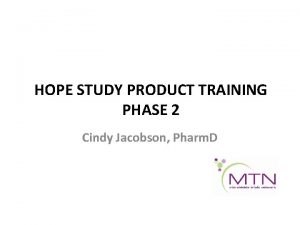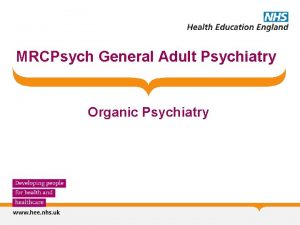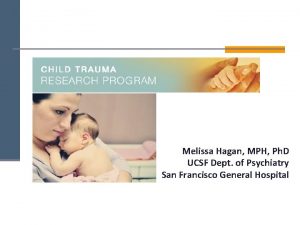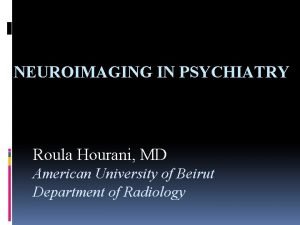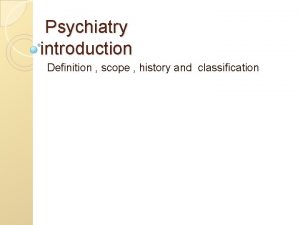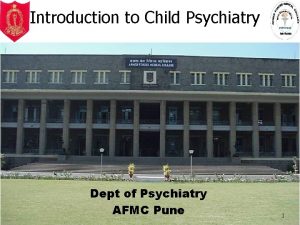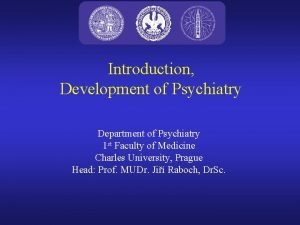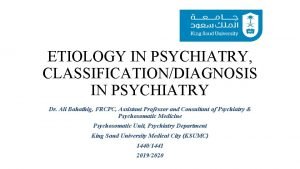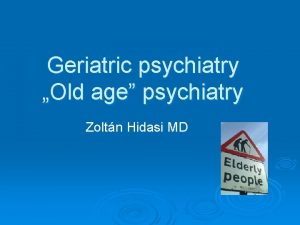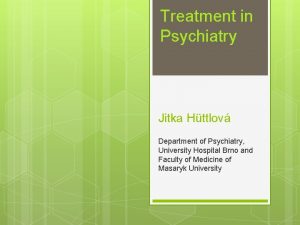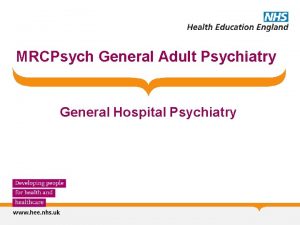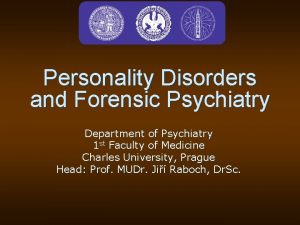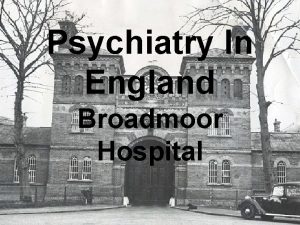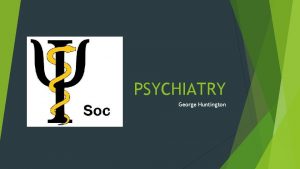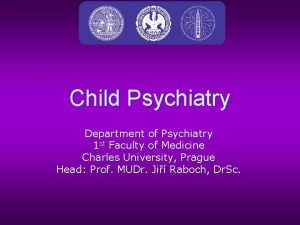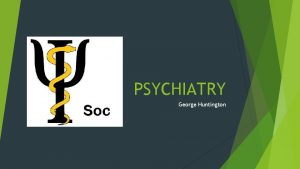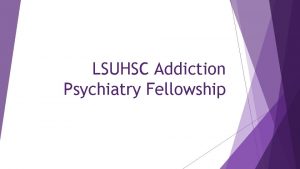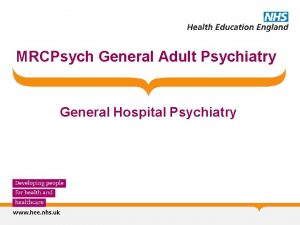Clinical Application of Neuroimaging in Psychiatry Cindy Hagan






















































- Slides: 54

Clinical Application of Neuroimaging in Psychiatry Cindy Hagan, Ph. D Postdoctoral Research Associate Brain Mapping Unit Department Psychiatry

Overview • Neuroimaging approaches • Challenges of psychiatric research • Ways neuroscientists try to overcome challenges – Hypothesis-driven approaches – Data-driven approaches • Conclusions

Neuroimaging can take different forms • Computerised Tomography (CT) – Xray photons lose energy as they pass through materials with different densities. Bone white, CSF black – Used for focal CNS signs, delirium, abnormal EEG

CT head Extradural Subarachnoid haematoma haemorrhage

Neuroimaging can take different forms • Magnetic Resonance Imaging (MRI) – Magnetic properties of hydrogen and its interaction with both a large external magnetic field and radiowaves – Indicated for organic brain disease/demyelination/degeneration/ambiguous CT findings – Contraindicated- metallic implants/pregnancy

MRI head

Neuroimaging can take different forms • CT Pros and Cons – good for intracranial haemorrhage or calcified lesions, quick – Cheap & dirty • MRI Pros and Cons – superior tissue contrast and spatial resolution – expensive, noisy, claustrophobic


How does s. MRI/f. MRI research work? Process Data MRI Scanner Stimulus (e. g. picture) Process Data Brain Images

Neuroimaging has obvious medical uses Benefits: • Cheaper than WADA and electrical cortical mapping • Non-invasive • 52% patients alter extent of surgical resection • 42% patients alter surgical plans itself • 63% patients avoided further studies • Helps physician, patient and family make more informed decisions

What is the utility of neuroimaging for psychiatry?

Anxiety Depression (1) Depressed or irritable mood AND/OR (2) Diminished interest/pleasure (anhedonia) (1) Excessive anxiety and worry AND (2) Difficulty controlling anxiety and worry PLUS 4+ symptoms following: (3) Significant weight loss or gain (4) Insomnia or hypersomnia (5) Psychomotor agitation or retardation (6) Fatigue or loss of energy (7) Feelings of worthlessness or guilt (8) Impaired concentration, indecisiveness (9) Recurrent thoughts of death, suicide PLUS 3+ symptoms following: (3) Feeling wound-up, tense, or restless (4) Easily fatigued/worn-out (5) Concentration problems (6) Irritability (7) Significant tension in muscles (8) Difficulty sleeping PTSD (1) Traumatic event exposure AND (2) Feelings of intense fear, helplessness PLUS 1+ re-experiencing symptoms: (3) Recurrent thoughts of the event (4) Recurrent nightmares of the event (5) Dissociative episodes, hallucinations (6) Exposure-related distress PLUS 3+ persistent avoidant symptoms: (7) Trauma-associated thought avoidance (8) Trauma-associated activity avoidance (9) Diminished recall of trauma (10) Diminished interest (11) Feeling of detachment (12) Restricted affective range (13) Sense of a foreshortened future PLUS 2+ persistent arousal symptoms: (14) Difficulty sleeping (15) Irritability or angry outbursts (16) Impaired concentration (17) Hypervigilance (18) Exaggerated startle response

Anxiety Depression Unique symptoms (? ) Weight loss/gain Worthlessness/guilty feelings Thoughts of death or suicide Fatigue Restlessness Unique symptoms (? ) Excessive anxiety or worry Muscle tension Irritability Impaired concentration Difficulty sleeping Anhedonia Foreshortened sense of future Restricted affect Trouble controlling anxiety/worry Unique symptoms (? ) Traumatic event exposure Feelings of intense fear, helplessness Recurrent thoughts of the event Recurrent nightmares of the event Dissociative episodes, hallucinations Trauma-associated thought avoidance Trauma-associated activity avoidance Diminished recall of trauma Feeling of detachment Hypervigilance Exaggerated startle response PTSD

Challenges of psychiatric research • Considerable variability within and lack of variability between psychiatric diagnoses

Challenges of psychiatric research • Considerable variability within and lack of variability between psychiatric diagnoses • Psychiatric diagnoses rely on retrospective accounts of behaviour • Inherently difficult when memory impairment is a clinical/sub-clinical feature of the disorder

Challenges of psychiatric research • Considerable variability within and lack of variability between psychiatric diagnoses • Psychiatric diagnoses rely on retrospective accounts of behaviour • Inherently difficult when memory impairment is a clinical/sub-clinical feature of the disorder • ADHD symptoms present prior to age 7

Challenges of psychiatric research • Considerable variability within and lack of variability between psychiatric diagnoses • Psychiatric diagnoses rely on retrospective accounts of behaviour • Inherently difficult when memory impairment is a clinical/sub-clinical feature of the disorder • ADHD symptoms present prior to age 7 • Assumes patient provides objective accounts of his/her (past) behaviour

Why is neuroimaging exciting for psychiatry? • Potential to increase validity and accuracy of individual diagnoses – Permits one to “carve nature at its joints” by focusing on objective biological (quick) rather than subjective behavioural (time-consuming)criteria

Anxiety Depression Unique symptoms (? ) Weight loss/gain Worthlessness/guilty feelings Thoughts of death or suicide Fatigue Restlessness Unique symptoms (? ) Excessive anxiety or worry Muscle tension Irritability Impaired concentration Difficulty sleeping Anhedonia Foreshortened sense of future Restricted affect Trouble controlling anxiety/worry Unique symptoms (? ) Traumatic event exposure Feelings of intense fear, helplessness Recurrent thoughts of the event Recurrent nightmares of the event Dissociative episodes, hallucinations Trauma-associated thought avoidance Trauma-associated activity avoidance Diminished recall of trauma Feeling of detachment Hypervigilance Exaggerated startle response PTSD

Why is neuroimaging exciting for psychiatry? • Potential to increase validity and accuracy of individual diagnoses – Permits one to “carve nature at its joints” by focusing on objective biological (quick) rather than subjective behavioural criteria (time-consuming) – Allows us to observe the unobservable

Lennox et al. , Lancet 1999 Individual internal experiences

De Charms et al. , PNAS 2005 © 2005 by National Academy of Sciences

Owen et al. , Science 2006 rate of misdiagnosis is approximately 40% 25 year old woman in persistent vegetative state

Monti et al. , New England Journal of Medicine 2010

Why is neuroimaging exciting for psychiatry? • Potential to increase validity and accuracy of individual diagnoses – Permits one to “carve nature at its joints” by focusing on objective biological rather than subjective behavioural criteria – Allows us to observe the unobservable – Can be used to inform about current validity of diagnostic criteria

Hypothesis-driven research Developmental taxonomic theory: Adolescent form is result of social mimicry and so only childhood form of disorder should display abnormal patterns of neural activity.

Passamonti et al. , AGP 2010 Angry-Neutral Faces

From: Amygdala Activation During Emotion Processing of Neutral Faces in Children With Severe Mood Dysregulation Versus ADHD or Bipolar Disorder Brotman et al. , 2010 Am J Psychiatry. 2009; 167(1): 61 -69. doi: 10. 1176/appi. ajp. 2009. 09010043 “determining the neural circuitry engaged in processing neutral faces may assist in the differential diagnosis of disorders with overlapping clinical features” Task: rate fear/nose width in each (neutral) face Left amygdala activity Copyright © American Psychiatric Association. All rights reserved.

Drevets et al. Current Opinion in Neurobiology 2008 Functional anatomy of depression – Emotion processing network abnormalities Overactive anterior cingulate cortex. Overactive amygdalae – feedback loop between the two

Disner, Beevers, Haigh & Beck, NRN general the negative cognitive 2011 “…in biases in depression are facilitated by increased influence from subcortical emotion processing regions (blue) combined with attenuated top-down cognitive control (grey). ”

Mayberg et al. Neuron 2005 “It is as though I have just suddenly shifted from a state of all consuming internal focus to realizing that there a number of things around to do…” “when you’re depressed the focus is inward. Whatever you just did, I don’t feel that inward look; it has lifted so I am not so focused on myself…” N=6; 6 mos DBS 4 responders = 66% efficacy rate Similar efficacy rate for later study with N=20 “it is as though I have been locked in a room with 10 screaming children. Constant noise; no rest, no escape. Whatever just happened, the children have just left the building. ”

Mayberg et al. , 2005 data-driven approach http: //www. youtube. com/watch? v=ZXuz. Jugr. L 1 Y 15. 20~17: 30

Structural MRI • Typically used to show differences in grey matter density in clinical populations versus healthy control subjects

First demonstration of structural brain abnormality in psychiatric disorder

Structural MRI

Structural MRI • Typically used to show differences in clinical populations versus healthy control subjects • Long way from using structural scans to diagnose patients but there is hope…

Structural MRI • Typically used to show differences in clinical populations versus healthy control subjects • Long way from using structural scans to diagnose patients but there is hope… • Recent advances taken from functional imaging and applied to structural imaging

Multivariate Pattern Analysis (MVPA) • Data-driven approach

Multivariate Pattern Analysis (MVPA) • Data-driven approach • May be more sensitive to widespread changes in the brain or differences in local information coding than conventional univariate methods (voxels independent)

Multivariate Pattern Analysis (MVPA) • Data-driven approach • May be more sensitive to widespread changes in the brain or differences in local information coding than conventional univariate methods (voxels independent) • Possibly better for prediction of disease onset, clinical outcomes, or distinguishing endophenotypes

Multivariate Pattern Analysis (MVPA) • Data-driven approach • May be more sensitive to widespread changes in the brain or differences in local information coding than conventional univariate methods (voxels independent) • Possibly better for prediction of disease onset, clinical outcomes, or distinguishing endophenotypes • Potential to gain insight to neural determinants of various diseases (labeled vs unlabeled data techniques)

Multivariate Pattern Analysis (MVPA) • Data-driven approach • May be more sensitive to widespread changes in the brain or differences in local information coding than conventional univariate methods (voxels independent) • Possibly better for prediction of disease onset, clinical outcomes, or distinguishing endophenotypes • Potential to gain insight to neural determinants of various diseases (labeled vs unlabeled data techniques) • Best practice is to cross-validate data

MVPA • Used for “brain reading” – use patterns of brain activity or structure to reversely infer groups or conditions SPM/FSL

Hasson et al. Science 2004 • Most popular application of multivariate pattern analysis (“reverse correlation”) • Activity in face versus place brain areas predicted what was on the screen in the movie

MVPA • Used for “brain reading” – use patterns of brain activity or structure to reversely infer groups or conditions • Doesn’t ask to what degree a voxel responds to one condition over another, rather which spatial patterns of brain activity are characteristic of the brain during one condition over another or in one clinical group over another

Hoeft et al. , 2008 http: //www. youtube. com/watch? v=_byqo. PW _XFk Over 90% prediction accuracy for Fra. X versus DD or controls

MVPA • Classification of Alzheimer’s disease irrespective of scanning centre (Kloppel et al. , 2008)

MVPA • Possible questions: – Identification of disorder subtypes – Do abnormal patterns of activity or structure predict aberrant cognitive development in longitudinal data sets? – Do patterns of activity relating to concentration problems in depression overlap with those seen in anxiety and PTSD?

Hoeft et al. AGP 2011 – Different trajectories of brain development identified as early as 1. 5 years across groups – SVM revealed overall pattern of brain structure in i. AUT generally resembled that of the controls more than FXS, both with and without AU

James Watson, 1968 “Science seldom proceeds in the straightforward logical manner imagined by outsiders. Instead, its steps forward (and sometimes backward) are often very human events in which personalities and cultural traditions play major roles. ”

Use and limitations of neuroimaging in Psychiatry • Permits greater understanding of disorder

Use and limitations of neuroimaging in Psychiatry • Permits greater understanding of disorder • Often, but not always, applicable at group rather than individual level – Imaging may be used as a supplement to narrow down clinical focus

Use and limitations of neuroimaging in Psychiatry • Permits greater understanding of disorder • Often, but not always, applicable at group rather than individual level – Imaging may be used as a supplement to narrow down clinical focus • At individual level, can be used as biofeedback mechanism or to predict treatment response – Clinicians are essential for generalisation

End
 Neuroimaging
Neuroimaging Merle sepp
Merle sepp Vayan y hagan que todos sean mis discípulos letra
Vayan y hagan que todos sean mis discípulos letra Kenzie hagan
Kenzie hagan Paso 1: hagan una pregunta
Paso 1: hagan una pregunta Heather hagan
Heather hagan For adult
For adult Ryan hagan wrestling
Ryan hagan wrestling Escribe hagan
Escribe hagan Uta hagan
Uta hagan Ahorado
Ahorado Assessment skills
Assessment skills Core psychiatry
Core psychiatry European psychiatry
European psychiatry Gipsofia
Gipsofia Addiction expert witness
Addiction expert witness Geriatric psychiatry definition
Geriatric psychiatry definition National network of child psychiatry access programs
National network of child psychiatry access programs Psychiatry in ethiopia
Psychiatry in ethiopia National network of child psychiatry access programs
National network of child psychiatry access programs Mse speech
Mse speech Who is this
Who is this Asclepiades father of psychiatry
Asclepiades father of psychiatry Jamaica hospital psychiatry
Jamaica hospital psychiatry Radical psychiatry sociology
Radical psychiatry sociology Community geriatric psychiatry
Community geriatric psychiatry Obgyn shelf percentiles 2021
Obgyn shelf percentiles 2021 Neurosis vs psychosis
Neurosis vs psychosis Reconstructive memory psychology definition
Reconstructive memory psychology definition Cindy orser
Cindy orser Laura forgot her friends birthday
Laura forgot her friends birthday Cindy mcdaniel stuck in neutral
Cindy mcdaniel stuck in neutral Think synony,
Think synony, Dad and aunt cindy
Dad and aunt cindy The bald soprano sparknotes
The bald soprano sparknotes Cindy eisner
Cindy eisner Flaik tracker
Flaik tracker Dr cindy schalk
Dr cindy schalk Cindy bae
Cindy bae Cindy arrigo
Cindy arrigo Cindy giglio beaumont tx
Cindy giglio beaumont tx Cindy gasser
Cindy gasser Dr cindy wigley
Dr cindy wigley Cindy morrow midwife
Cindy morrow midwife Cindy kowalski
Cindy kowalski Cindy zheng
Cindy zheng Cindy ryder
Cindy ryder Cindy van de velde
Cindy van de velde Cindy acker
Cindy acker синди бруно
синди бруно Cindy crawford chemical engineering
Cindy crawford chemical engineering Cindy jacobson
Cindy jacobson Cindy pollack
Cindy pollack Cindy royal
Cindy royal Cindy secunda
Cindy secunda

